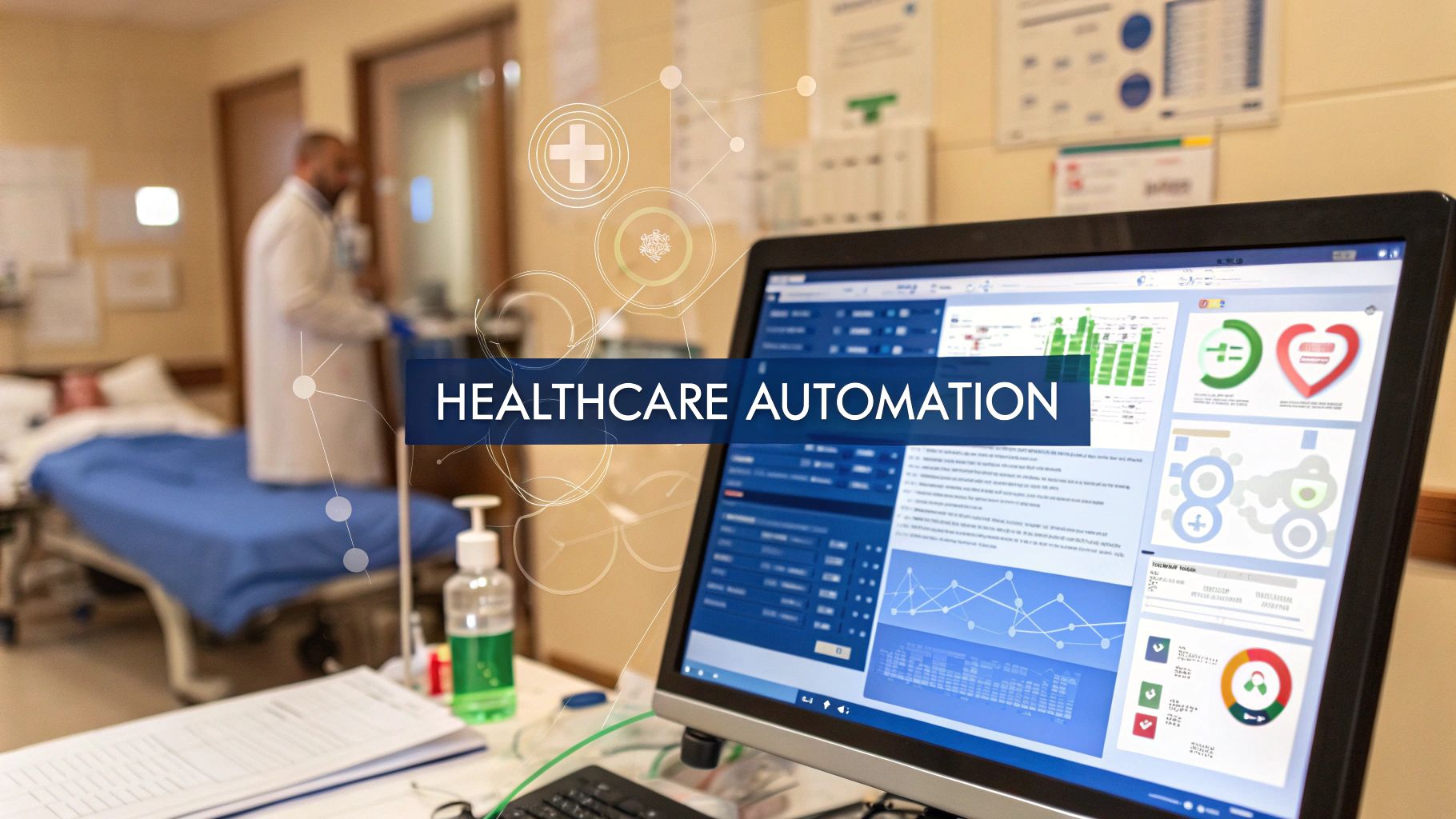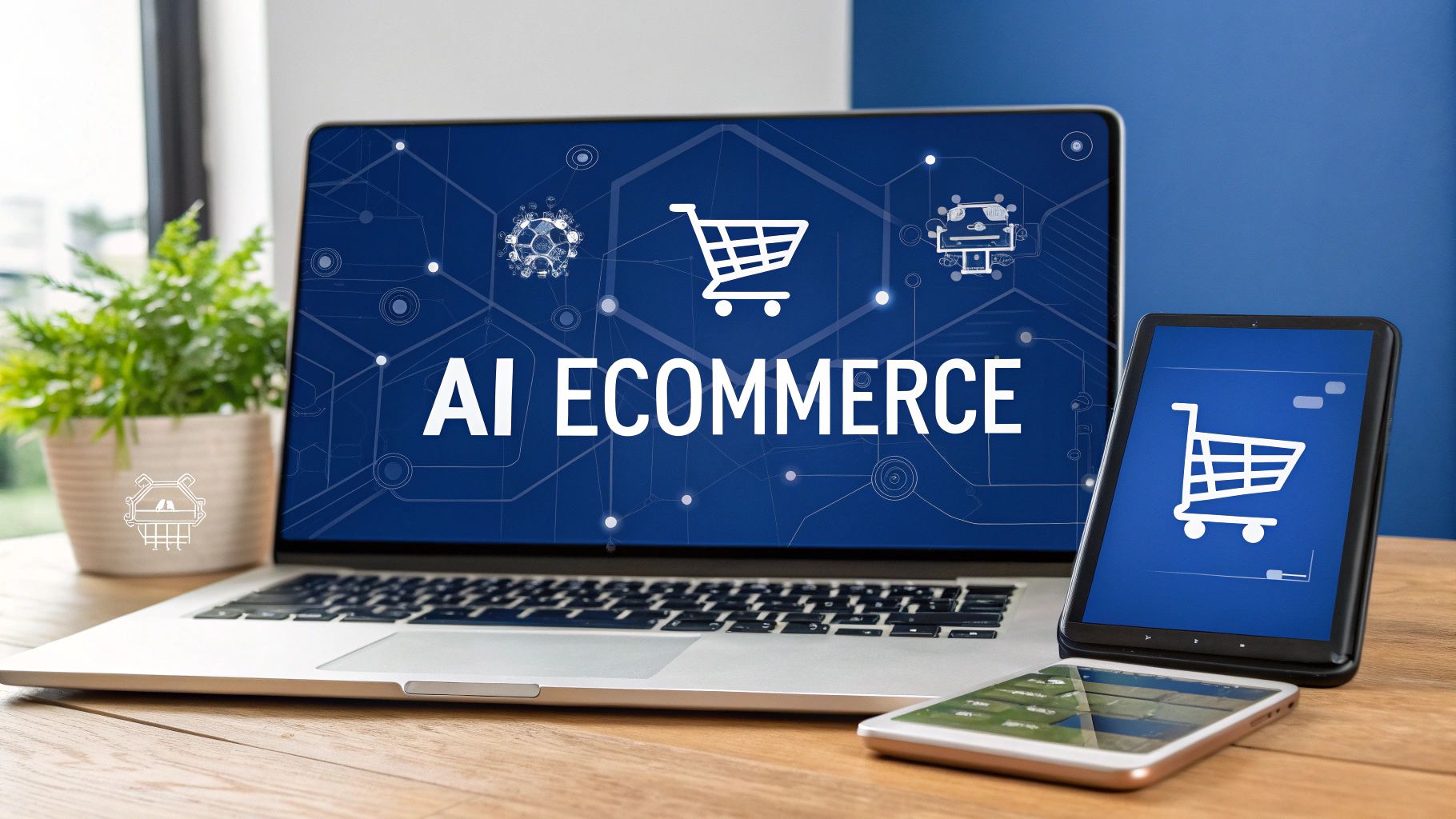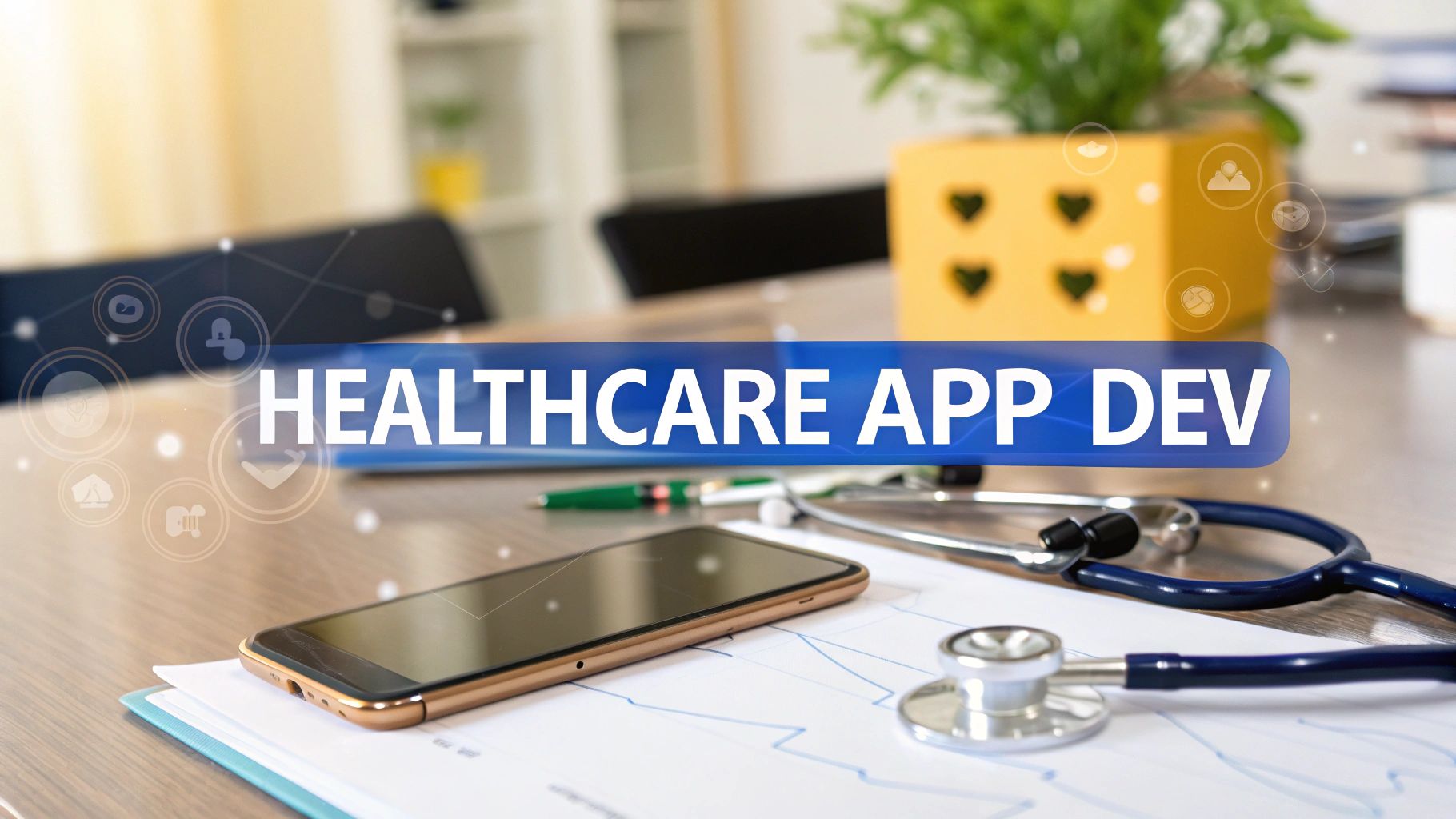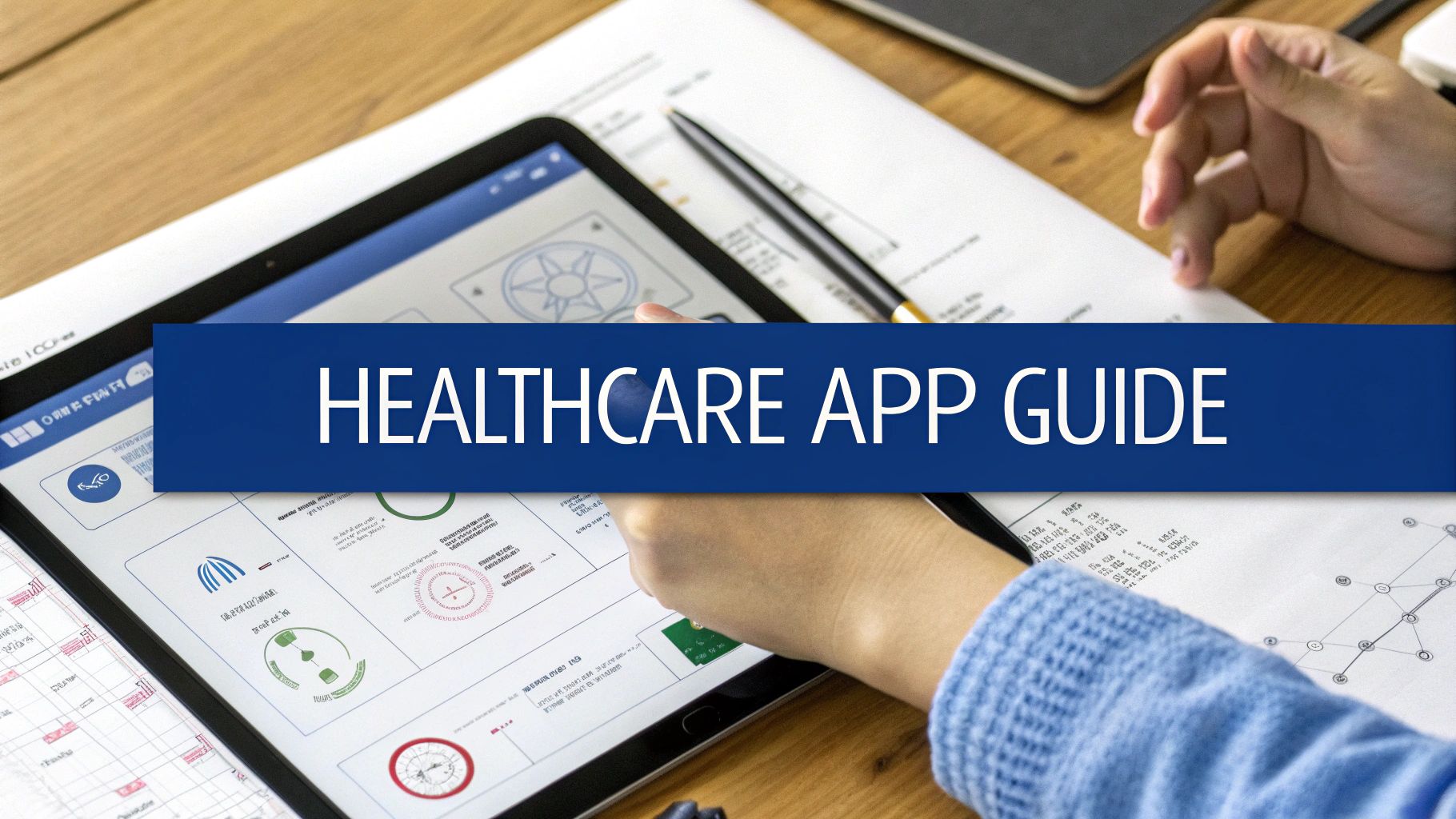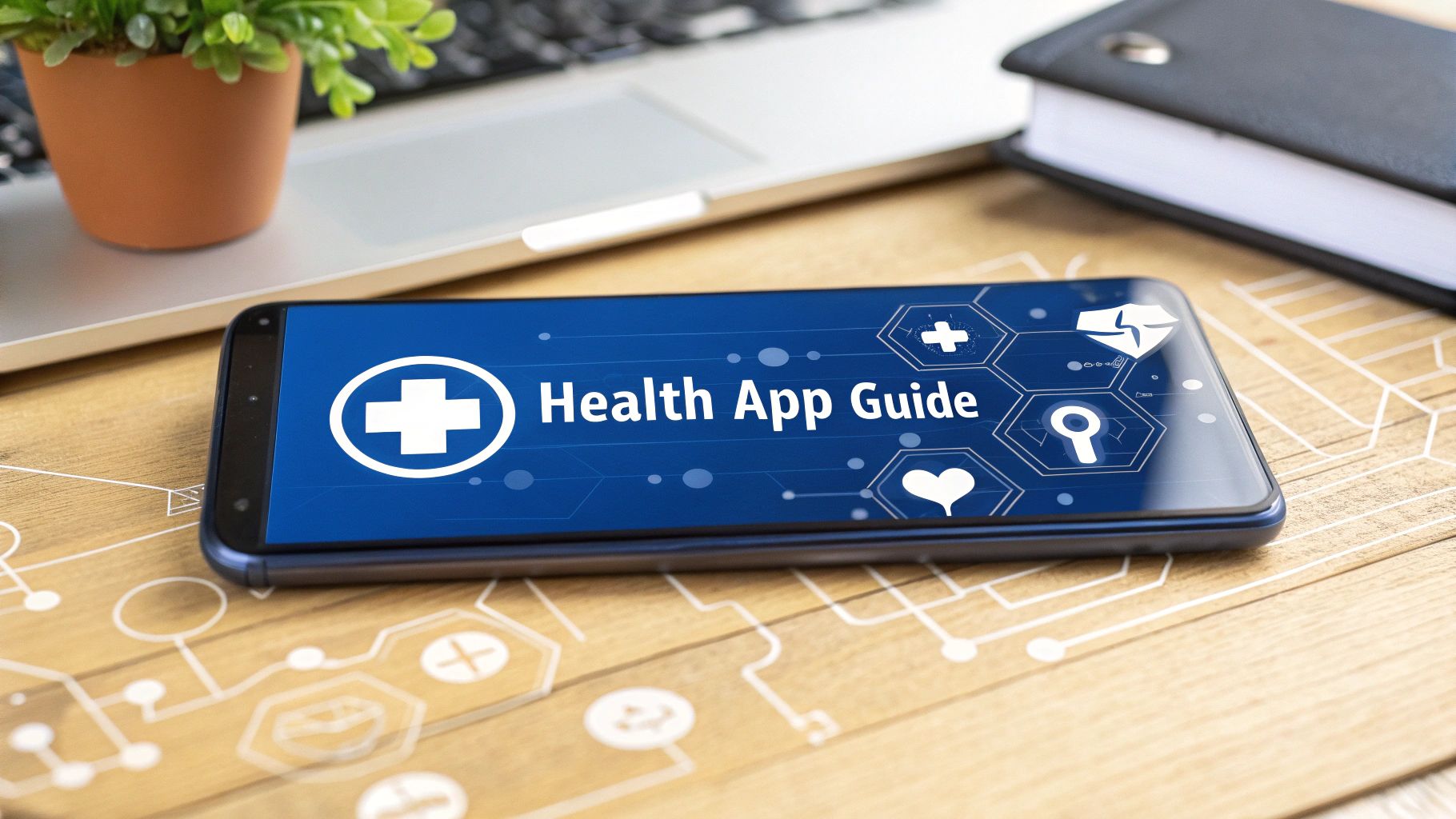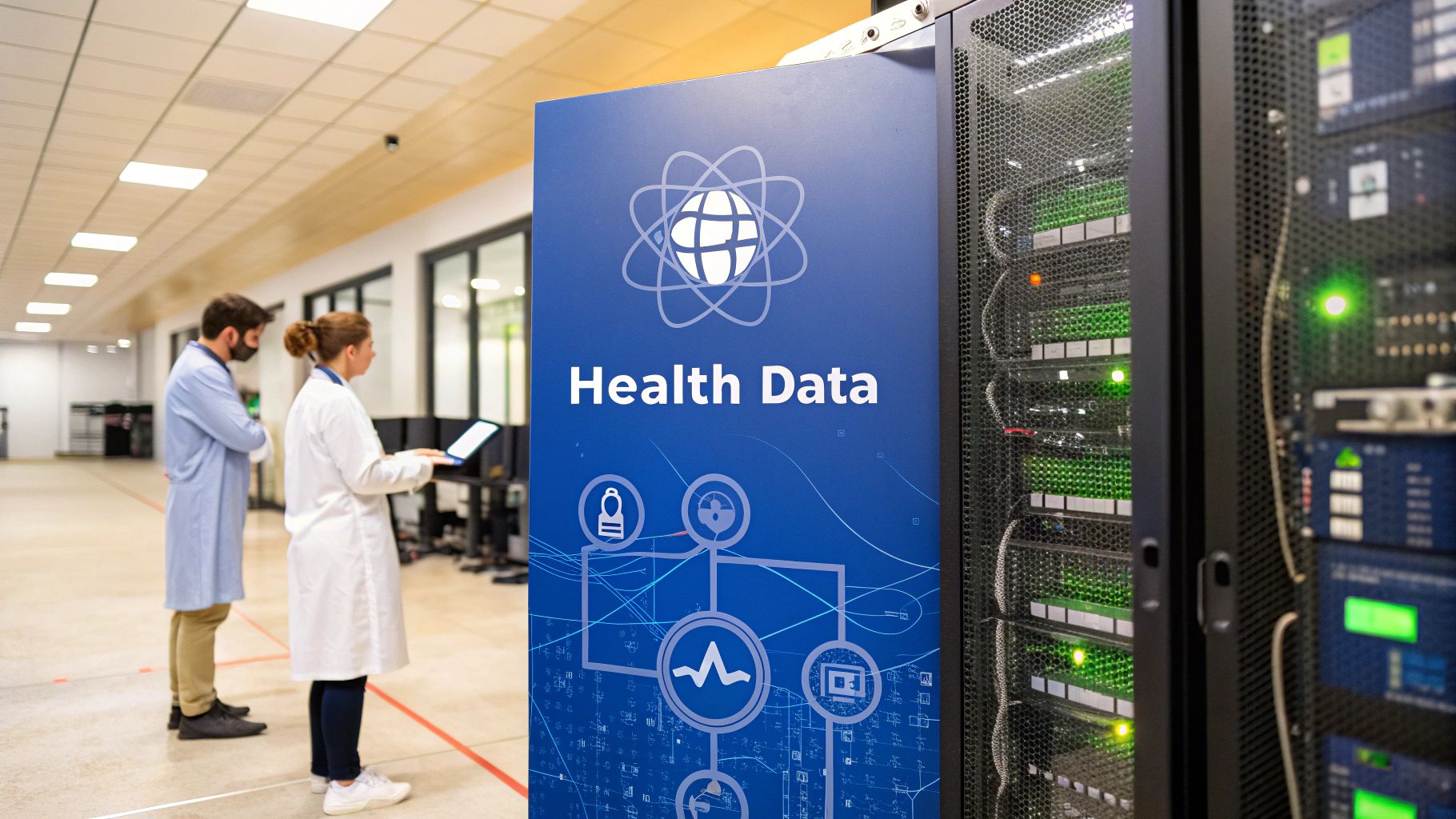Think of all the repetitive, time-consuming tasks that bog down a hospital or clinic. Scheduling, billing, data entry, managing records; it’s a mountain of administrative work. Healthcare automation is simply using technology to take over those tasks, freeing up doctors, nurses, and staff to focus on what truly matters: patient care.
What is Healthcare Automation Really?

Let’s use an analogy. A busy hospital operates like a complex orchestra. You have patient intake, scheduling, billing, and records management, and each section needs to be perfectly in sync. Traditionally, this coordination is manual, which opens the door to human error, frustrating delays, and staff burnout.
Healthcare automation acts as the conductor. It uses technology to coordinate every moving part, making sure each task is done right and on time.
This isn’t about replacing skilled medical professionals with robots. It’s about building a smarter support system; a “digital nervous system” that works tirelessly behind the scenes. It handles the predictable, essential jobs that don’t require human empathy or complex medical judgment, taking that administrative weight off the shoulders of your clinical team.
The Core Technologies Making it Happen
Two key pieces of technology are the engine behind modern healthcare automation: Robotic Process Automation (RPA) and Artificial Intelligence (AI).
Think of RPA as the system’s dependable hands. It’s programmed to follow clear rules for straightforward tasks like moving data from one system to another or sending out automated appointment reminders. It’s built for high-volume, repetitive work.
AI, on the other hand, is the brain. It can look at complex information, spot patterns, and offer intelligent insights. For instance, an AI tool could help a radiologist by flagging potential issues in medical scans or help with medical coding by accurately interpreting a doctor’s clinical notes. When you combine the hands (RPA) and the brain (AI), you get a powerful system that can tackle a huge range of challenges.
More Than Just Checking Off Tasks
At its heart, understanding healthcare workflow automation is key. It’s all about how technology can smooth out processes to improve patient care and bring down costs. Automation bridges the gaps between different departments and software, letting information flow where it needs to go without friction. That seamless connection is what creates a better, more efficient patient journey from start to finish.
The real power of healthcare automation is its ability to eliminate administrative headaches. When your systems can talk to each other and routine tasks just happen automatically, the entire process of delivering care becomes faster, safer, and much more centred on the patient.
This idea isn’t unique to medicine; it’s part of a much larger trend. If you’re curious about the fundamentals, learning what business process automation is provides a great background. But in healthcare, the goal is crystal clear: use technology to support clinicians, make operations more efficient, and deliver better outcomes for every single patient.
The Critical Benefits of Automating Healthcare
We’ve talked about what healthcare automation is, but the more important question is why it’s become such a vital part of modern medicine. The answer is found in the real, measurable benefits that ripple through every part of the healthcare system, from the front desk to the operating theatre, and most importantly, to the patients.
Think of automation as a direct response to one of the biggest problems plaguing healthcare today: administrative burnout. Doctors, nurses, and their support teams are often swamped with a never-ending list of repetitive tasks like data entry, processing insurance claims, and juggling appointments. This administrative burden drains time and energy that should be dedicated to patient care.
When you hand these tasks over to automated systems, you give medical professionals their most valuable asset back: their time. This single change allows them to concentrate on what they do best: making complex diagnoses, talking with patients, and providing the kind of empathetic care that technology simply can’t replicate.
Enhancing Operational Efficiency and Accuracy
One of the first things you’ll notice with automation is a massive jump in operational efficiency. Let’s be honest, manual processes are not just slow; they’re a breeding ground for human error. In a healthcare setting, a simple typo can spiral into incorrect billing, delayed treatments, or even a misdiagnosis.
Healthcare automation tackles these risks head-on by establishing consistent, rule-based processes. In fact, studies have shown that automating the revenue cycle alone can slash billing errors by up to 40%. That’s a direct boost to a facility’s bottom line and a huge relief for patients tired of confusing bills.
This improved accuracy goes far beyond just billing. Automated systems keep patient records updated across different departments in real-time, ensure medication orders are sent without any mistakes, and run compliance checks quietly in the background.
This infographic really drives home the difference between manual and automated workflows.

The numbers speak for themselves. Automation cuts administrative time in half, speeds up scheduling, and dramatically reduces costly billing mistakes. This boost in efficiency makes the entire healthcare system more dependable and sustainable.
Improving the Patient Experience
At the end of the day, the people who feel the benefits of healthcare automation the most are the patients. When a healthcare system runs more smoothly and accurately, the patient’s journey improves from the moment they book an appointment to their final follow-up.
For patients, this translates to:
- Faster Access to Care: Automated scheduling tools can find and confirm appointments in seconds. No more sitting on hold or waiting days for a callback.
- Clearer Communication: Automated reminders for appointments, prescription refills, and follow-up instructions keep patients in the loop and actively involved in their own health.
- Fewer Administrative Headaches: With precise, automated billing and insurance checks, patients are less likely to deal with confusing statements or unexpected costs.
- Quicker Access to Information: Secure patient portals, often powered by automation, provide immediate access to lab results, medical history, and treatment plans.
By removing these common points of friction, healthcare providers can build a more positive and empowering experience. When patients feel their time is valued and their information is managed correctly, it builds trust and leads to better health outcomes for everyone.
How Automation Works in Real Hospitals and Clinics

It’s one thing to talk about the theory, but seeing healthcare automation in practice is where its impact really hits home. Across Canada, hospitals and clinics are already putting these technologies to work, solving real-world problems and making patient care smoother and safer.
These aren’t far-off concepts from a sci-fi movie; they’re practical tools being used right now. From the moment a patient checks in to the detailed analysis of their medical scans, automation is there in the background, supporting clinicians and improving outcomes.
Let’s look at a few concrete examples of how this plays out day-to-day.
Patient Intake and Administration
Picture the emergency department of a busy city hospital. The old way of doing things was a chaotic mess of clipboards, manual data entry, and inevitable errors. This created bottlenecks and left patients waiting anxiously when they needed urgent care.
Now, many hospitals have automated their intake. A patient might pre-register on their phone before they even leave home or use a self-serve kiosk in the lobby. The system instantly verifies their health card, checks insurance details, and adds them to the triage queue, without a single sheet of paper.
This simple change does more than just save time. It cuts down on the costly data entry mistakes that cause billing headaches later and frees up admin staff to focus on patients who need one-on-one help.
This single application makes the patient’s experience better from the get-go while also protecting the hospital’s revenue cycle. It’s a classic win-win. For a closer look at what’s happening in this space, you can explore some of the different AI solutions for hospitals in Canada.
The difference between a manual process and an automated one becomes crystal clear when you compare them side-by-side.
Comparing Manual vs Automated Healthcare Tasks
| Healthcare Function | Challenges of the Manual Process | Benefits of the Automated Solution |
|---|---|---|
| Patient Registration | Long wait times, high risk of data entry errors, and heavy staff workload. | Instant check-in, accurate data capture, and staff free for complex issues. |
| Prescription Refills | Multiple phone calls, delays, potential for miscommunication. | Patient portal requests, instant verification, and secure e-prescribing to the pharmacy. |
| Appointment Scheduling | Phone tag with reception, limited to office hours, risk of double-booking. | 24/7 online booking, automated reminders, reduced no-shows. |
| Medical Imaging Analysis | High volume of scans, potential for human fatigue and oversight. | AI flags anomalies, prioritizes critical cases, and increases diagnostic accuracy. |
| Billing & Coding | Complex codes and, high chance of human error lead to claim denials. | Automated code suggestions, real-time error checking, and faster reimbursement. |
As the table shows, automation fundamentally changes how these essential tasks are performed, boosting both efficiency and quality.
The Prescription Refill Process
Another all-too-common headache is managing prescription refills. The traditional process was a frustrating cycle of phone calls bouncing between the patient, the pharmacy, and the doctor’s office, often resulting in delays and mix-ups.
Today, many clinics use systems that are built right into their Electronic Health Records (EHR). The new workflow is much cleaner:
- A patient puts in a refill request through a secure online portal or automated phone system.
- The software instantly scans the patient’s file to ensure the prescription is current and due for a refill.
- If it all checks out, a notification is sent to the physician for a quick, one-click approval.
- Once approved, the order is sent securely and directly to the patient’s pharmacy.
This automated loop ensures patients get their medication without interruption, lightens the administrative burden on clinic staff, and creates a perfectly clear audit trail for every prescription.
Enhancing Diagnostic Accuracy with AI
Perhaps the most powerful application of automation is in medical imaging. Radiologists are under immense pressure, analyzing hundreds of scans a day and searching for tiny abnormalities that could signal a serious disease.
AI-powered imaging tools are now acting as a second set of expert eyes. An AI can analyze an X-ray, CT scan, or MRI in seconds, flagging areas of concern for the radiologist to examine more closely. It can measure a tumour with pinpoint precision or spot the very earliest signs of a condition that might be missed by the human eye.
This technology doesn’t replace the radiologist, but supports them. By handling the initial screening and highlighting the most critical spots, these tools help specialists focus their skills where they matter most, leading to quicker and more accurate diagnoses. To understand how clinicians are integrating these kinds of tools into their practice, reading a cardiologist’s guide to the smartwatch ECG offers some fascinating real-world perspective.
Navigating the Challenges of Implementation
While the idea of healthcare automation is exciting, making it a reality isn’t as simple as flipping a switch. Bringing these powerful tools into a clinical or administrative setting is a major project, and it comes with its own set of very real hurdles. To get it right, you need careful planning and a clear-eyed view of the obstacles ahead.
Most of the challenges healthcare organisations run into fall into three buckets: the sheer complexity of the systems we already use, the significant upfront investment, and the absolute necessity of keeping patient data locked down. Skimping on any of these can stop a project in its tracks.
The Complexity of Medical Billing and Coding
Medical billing and coding is one of the thorniest parts of healthcare administration. It’s not just data entry; it’s a specialized language that’s always in flux. Diagnostic codes like ICD and procedural codes like CPT are updated all the time, which makes keeping both your systems and your people up to speed a constant operational headache.
A small mistake here isn’t a small problem. One wrong code can get an insurance claim denied flat out. That means lost revenue and hours of administrative clean-up just to get paid for the work you’ve already done. And as healthcare changes, this complexity only deepens.
For instance, a major issue facing healthcare automation in California by 2025 is this very problem. The shift to new systems like ICD-11 and frequent CPT updates requires massive retraining and system overhauls to keep reimbursements accurate. The explosion of telehealth has also added new wrinkles, where using the wrong modifier can get a claim kicked back instantly. You can read more about these top medical billing challenges on StatMedical.net.
Overcoming High Initial Costs
Let’s be frank: implementing a solid automation platform costs money. The initial price tag for software, new hardware, and getting everything to talk to your existing systems can be a big pill to swallow, especially for smaller clinics or hospitals on a tight budget.
But it’s critical to see this as a long-term investment, not just another expense on the books. To make the numbers work, here’s a practical approach:
- Start Small: Don’t try to boil the ocean. Pick one high-impact, high-frustration process, like patient scheduling or prescription refills, and automate that first. This gives you a clear win and demonstrates a real return on investment (ROI) on a manageable scale.
- Choose Scalable Solutions: Look for cloud-based subscription models. They let you scale up your automation as your needs grow, so you can avoid a massive capital spend right out of the gate.
- Do a Proper ROI Analysis: Map out the long-term savings you’ll see from fewer errors, more efficient staff, and getting paid faster. This builds a powerful business case that makes the initial investment much easier to justify.
When you take it one step at a time, that financial barrier starts to look a lot less intimidating.
The key is to shift the mindset from “cost” to “investment.” Successful automation implementation pays for itself over time by plugging revenue leaks, boosting productivity, and freeing up your most valuable resource: your clinical staff.
Ensuring Ironclad Data Security and Compliance
In healthcare, nothing is more important than data security. We’re dealing with the most sensitive information a person has, which means any automation system has to be built on a foundation of absolute security and strict compliance with regulations. Protecting patient privacy isn’t just good practice; it’s the law, governed by rules like PIPEDA in Canada.
A data breach can be catastrophic. We’re talking about massive fines, legal battles, and trust with your patients that, once broken, is nearly impossible to repair. Security can’t be an afterthought; it has to be baked into the solution from day one.
This means you need several non-negotiable layers of protection:
- End-to-End Encryption: All patient data must be scrambled and unreadable, both when it’s sitting on a server and when it’s being sent from one place to another.
- Strict Access Controls: People should only be able to see the information they absolutely need to do their jobs. A scheduler doesn’t need to see a patient’s full clinical history.
- Regular Security Audits: You have to constantly test your systems for weak spots to stay one step ahead of anyone who might try to get in.
Figuring out the ins and outs of data privacy is a huge part of any automation project. For Canadian organisations, it’s essential to get this right. You can learn more in our guide on AI in healthcare data privacy in Canada. At the end of the day, a successful implementation finds the perfect balance between making things more efficient and an unwavering promise to keep patient information safe.
The Role of AI in Supercharging Automation
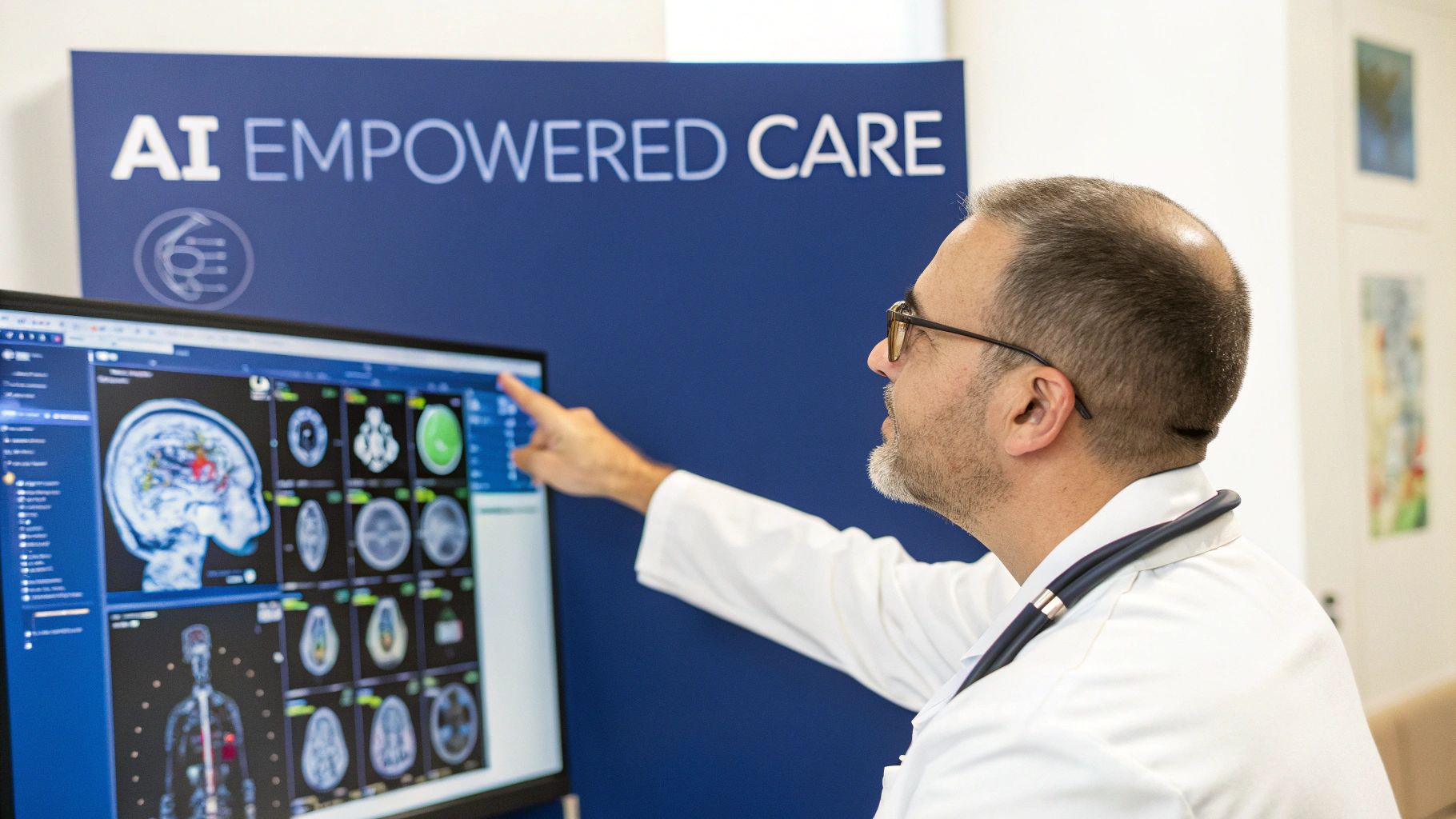
Think of basic automation as a reliable delivery truck; it gets you from point A to point B following a set route. Now, imagine putting a high-performance, self-navigating engine in that truck. That’s what Artificial Intelligence (AI) does for healthcare automation. It injects speed, intelligence, and the ability to navigate complex situations all on its own.
This is where the real magic happens. Standard automation is a workhorse for repetitive, predictable tasks. But healthcare is rarely predictable. AI steps in to handle that variability. By learning from enormous datasets, recognizing subtle patterns, and even understanding human language, AI opens up a whole new playbook for what’s possible.
Instead of just shuffling data from one spreadsheet field to another, AI-powered automation can actually interpret what that data means. This turns automation from a simple administrative tool into a powerful partner for both clinical and operational teams.
From Task Management to Intelligent Decision Support
AI supercharges automation by adding a layer of cognitive skill. The goal is no longer just about doing tasks faster; it’s about doing them smarter. We’re already seeing this intelligence make a real difference in clinics and hospitals across the country.
A perfect example is medical coding. An AI system can analyze a physician’s spoken notes from a patient visit, pick out the key medical terms, and suggest the most accurate billing codes. This saves an incredible amount of time and drastically cuts down on the human errors that lead to costly claim denials.
In the clinic itself, AI can offer real-time decision support. It might analyze a patient’s symptoms, medical history, and lab results to present a clinician with potential diagnoses or evidence-based treatment options. It’s like having an expert consultant available on demand, instantly.
AI doesn’t replace the expertise of a doctor or coder. Instead, it acts as a powerful amplifier, processing mountains of information in seconds to provide insights that help human experts make faster, more informed decisions.
This isn’t some futuristic fantasy. It’s a practical application of technology that’s tackling some of the biggest headaches in healthcare today, from administrative burnout to diagnostic complexity.
AI Applications in Everyday Healthcare
The impact of AI in automation is already here. In fact, adoption is accelerating. In places like California, AI is expected to play a huge part in workflow automation and medical coding by 2025.
Across the board, about 63% of healthcare organisations are already using AI, with another 31% running pilot projects. This push is driven by the urgent need to slash administrative costs and boost efficiency, particularly for tasks like automating clinical notes and analyzing documents. You can discover more insights about healthcare trends on rsisecurity.com to see the broader picture.
Here are a few ways AI is already reshaping daily workflows:
- Intelligent Patient Communication: AI-powered chatbots are now a common first point of contact for patients. They can handle routine questions, help book appointments, and even triage symptoms to guide patients to the right level of care. This frees up staff for more complex conversations.
- Automated Clinical Note Generation: A branch of AI called Natural Language Processing (NLP) can listen in on a doctor-patient conversation. It then drafts accurate, structured clinical notes directly into the Electronic Health Record (EHR), all but eliminating the after-hours charting that burns out so many physicians.
- Enhanced Diagnostic Imaging: AI algorithms are now trained to analyze medical scans like X-rays and MRIs, flagging potential abnormalities for radiologists to review. This helps prioritize urgent cases and provides a reliable “second set of eyes” to catch subtle issues that might otherwise be missed.
Each of these examples shows AI doing more than just automating a simple task. It’s interpreting complex information, interacting intelligently, and providing support that tangibly improves both efficiency and the quality of patient care. It’s this cognitive boost that truly supercharges healthcare automation.
How Automation is Reshaping the Healthcare Workforce
Let’s tackle the big question right away: Does automation in healthcare mean fewer jobs for people? It’s a common concern, but the reality is far more nuanced and, frankly, a lot more optimistic. Automation isn’t about replacing people; it’s about reallocating their incredible skills to where they matter most.
Think of it less as a replacement and more as a highly capable digital assistant. Its job is to take on the repetitive, soul-crushing administrative work that so often leads to burnout. By absorbing these monotonous tasks, automation elevates the human element.
This shift creates space for healthcare professionals to do what they do best. They get to spend more of their time on critical thinking, handling complex patient cases, and building the kind of trusting, human-to-human connections that no technology can ever replicate.
Shifting Roles from Repetitive to Strategic
Instead of being a threat, automation is actually a catalyst for upskilling the entire workforce. It empowers every single team member to operate at the very top of their licence, focusing on high-value work that truly requires their expertise.
The focus naturally moves from tedious data entry to insightful data analysis, from manual scheduling to meaningful patient engagement. Here’s a glimpse of how roles are already evolving:
- Administrative Staff: Instead of being buried under phone calls and paperwork, they become true patient navigators, guiding people through their care journey and handling complex questions.
- Nurses and Medical Assistants: They’re no longer chasing down lab results or manually updating charts. This frees them up for more direct patient interaction, education, and hands-on care.
- Physicians and Specialists: With documentation and administrative burdens lifted, they can dedicate their full cognitive energy to complex diagnoses and building stronger, more trusting patient relationships.
Automation isn’t about making healthcare less human; it’s about removing the robotic tasks from human jobs. It gives skilled professionals the breathing room to focus on the parts of their work that truly make a difference.
A Powerful Tool to Address Staffing Shortages
Perhaps most importantly, automation is a critical strategy for tackling the widespread staffing shortages plaguing the industry. Making existing teams more efficient and effective helps healthcare organisations accomplish more with the talented people they already have.
For instance, in California, while AI and automation are starting to influence some roles, their main purpose is to improve how healthcare is delivered. As the sector looks toward 2025, automating workflows is seen as a key strategy for managing staffing challenges and curbing the immense administrative spending that strains the system. By automating tasks in areas like billing, organisations can redirect precious resources back where they belong: into patient care. You can find more insights on how automation is transforming healthcare billing at p3care.com.
Ultimately, automation helps build a more sustainable and resilient workforce; one that’s less bogged down by tedious work and better equipped to handle the growing demands of modern healthcare.
Your Healthcare Automation Questions, Answered
Even when you understand the theory, practical questions always pop up when it’s time to actually consider bringing automation into a healthcare setting. Here are some straightforward answers to the questions we hear most often.
How Does Automation Actually Make Patient Care Safer?
At its heart, automation boosts patient safety by taking human error out of the equation for routine tasks. Healthcare professionals are dedicated and highly skilled, but fatigue and repetition can lead to mistakes. In a medical environment, even a small slip-up can have big consequences.
Automation provides a reliable safety net in a few key ways:
- Catching Medication Errors: Computerized Physician Order Entry (CPOE) systems, for example, make sure prescriptions are clear and correct. They can automatically flag dangerous drug interactions or wrong dosages before a prescription ever gets filled.
- Improving Diagnostic Accuracy: AI tools can help radiologists spot tiny anomalies on medical scans that the human eye might overlook. This leads to catching problems earlier and diagnosing them more accurately.
- Confirming Patient Identity: Automated systems use simple tools like barcodes to double-check that the right patient is getting the right treatment or medication, every single time.
By building these safeguards directly into daily workflows, automation creates a much more secure and dependable environment for patients.
I Run a Small Clinic. Where Do I Even Begin?
For a smaller practice, the thought of implementing healthcare automation can definitely feel like a massive undertaking. The secret is not to try and fix everything at once. The best way forward is to start small by targeting your single biggest operational headache.
The most practical first step for any small clinic is to pinpoint one administrative task that drains the most time and energy. Is it scheduling? Chasing down payments? Sending appointment reminders? Pick one and solve it.
Finding a simple, cloud-based tool designed for that specific problem is the perfect way to start. This approach delivers a clear, quick return on your investment, which builds confidence and makes it much easier to justify expanding your automation efforts later on.
Is This Technology Going to Replace My Doctor?
This is a big one, but the answer is a clear and simple no. The entire purpose of automation and AI in medicine is to support and enhance a doctor’s skill and judgement, not to replace them. Think of it as the ultimate medical assistant.
By handling the tedious administrative work and sifting through mountains of data, these tools free up a doctor’s time. That lets them focus on the things only a human can do: listen with empathy, diagnose tricky conditions, craft a truly personal treatment plan, and build the kind of trust that is so crucial to good medicine.
At Cleffex Digital Ltd, we develop secure, compliant, and AI-driven solutions that empower healthcare organisations to improve efficiency and patient outcomes. Learn how we can help you navigate your automation journey at https://www.cleffex.com.
